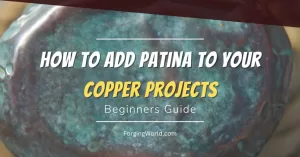If you’re a budding blacksmith or bladesmith, you’re probably on the lookout for new materials to work with. Well, today we’re diving into the world of copper forging.
Copper is a beautiful, versatile, and relatively easy-to-work-with metal that’s perfect for beginners looking to broaden their skills.
So, let’s jump right into this comprehensive guide on how to forge copper!
Why Copper?
Copper is an excellent choice for beginners because it has a lower melting point than other metals like steel, brass, and bronze. This means it’s easier to heat, work, and shape. Plus, who doesn’t love that stunning, warm reddish hue?
If you’ve already tried your hand at forging brass or wondered if you can forge bronze, copper is another fantastic option to explore.
Getting Started: Tools and Materials
Before we jump into the process, let’s go over the tools and materials you’ll need:
- Copper: You can find copper in various forms, such as bars, rods, sheets, or wire. Pick the form that suits your project best.
- Forge: A propane forge will work well for copper forging. If you’re unsure about propane forge temperatures, check out our guide on propane forge temperatures.
- Hammer and anvil: These are your essential tools for shaping the copper.
- Tongs: You’ll need these to handle the hot copper safely.
- Quenching bucket: A container filled with water for cooling the copper after forging.
- Safety gear: Don’t forget your safety glasses, gloves, and apron!
How to Forge Copper
Now that you’re all set up, let’s get to the fun part – forging!
Step 1: Heat the Copper
Place your copper piece into the forge and heat it until it becomes red-hot. Copper’s melting point is around 1,981°F (1,083°C), but you won’t need to get it that hot for forging. Aim for a cherry-red color, which is around 1,300°F (704°C). You can use a pyrometer to measure the temperature accurately.
Step 2: Shape the Copper
Once the copper is hot enough, use your tongs to remove it from the forge and place it onto your anvil. Now, you can start shaping it with your hammer. Copper is quite malleable, so it should be easy to work with. Be sure to work quickly, though, as copper cools down fast.
If the copper becomes too hard to work with, reheat it in the forge and repeat the process.
Step 3: Quench and Cool
When you’re satisfied with the shape of your copper piece, use your tongs to submerge it in your quenching bucket. This will cool down the copper and make it safe to handle.
Step 4: Clean and Finish
Once your copper has cooled, it’s time to clean and finish it. Use a wire brush to remove any scale or residue, and then polish it with sandpaper, steel wool, or buffing wheels to achieve your desired finish.
Step 5: Patina (Optional)
If you want to add some character to your copper piece, you can apply a patina. A patina is a thin layer that forms on the surface of the metal due to oxidation or chemical reactions. Patinas can add a unique, aged, or artistic look to your finished piece.
There are several ways to create patinas on copper, such as using vinegar, salt, ammonia, or even specific patina chemicals.
To try a simple patina, mix equal parts vinegar and salt, then apply the mixture to your copper piece. Let it sit for a while, and you’ll start to see the patina forming.
Rinse the piece with water, and then seal the patina with a clear lacquer to preserve it.
Tips and Tricks for Copper Forging
Now that you know the basics of copper forging, let’s cover some tips and tricks to help you on your journey:
Watch out for work-hardening: Copper work-hardens quickly, meaning it becomes more brittle and harder to shape as you work with it. If you find that your copper piece is getting too hard, just reheat it in the forge to soften it.
Practice makes perfect: Like any other skill, forging takes practice. Don’t be discouraged if your first few attempts aren’t perfect – keep working at it!
Experiment with textures: Copper’s malleability makes it an excellent material for adding textures and patterns. You can use various hammers, chisels, or punches to create unique designs.
Combine materials: Copper pairs beautifully with other metals like brass, bronze, and silver. Feel free to experiment with combining these materials in your projects for interesting contrasts and visual appeal.
Stay safe: Copper forging can be a lot of fun, but always remember to prioritize safety. Wear appropriate protective gear, and always be cautious when handling hot metal.
Frequently Asked Questions
Yes, you can forge copper using a charcoal forge. In fact, charcoal forges can produce higher temperatures than propane forges. Just make sure you’re using the right type of charcoal, as not all charcoal is suitable for forging. Learn more about the best fuel for a blacksmith forge to find the right type for your needs.
Copper can be forge-welded, but it’s a bit more challenging than forge-welding materials like steel due to its lower melting point and the formation of oxides. You might need to use a flux specifically designed for copper to prevent oxidation and achieve a successful weld.
Absolutely! Copper is a popular material for forging jewelry due to its malleability and unique color. You can create rings, bracelets, pendants, earrings, and more using forged copper. Just be aware that some people may have skin sensitivities to copper, so consider using a clear lacquer or coating to prevent direct skin contact if you’re making wearable items.
Yes, annealing copper can help make it more malleable and easier to forge. To anneal copper, heat it to a cherry-red color (around 1,300°F/704°C) and then allow it to cool slowly, either by turning off the forge and letting it cool inside or by placing it on a heat-resistant surface away from drafts. This process softens the metal and makes it easier to work with.
As a beginner, you may want to start with metals that are relatively easy to forge, like copper, brass, and mild steel. Check out our guides on how to forge brass and what is the easiest steel to forge to learn more about working with these materials.
Final Thoughts
Now that you have a good grasp on forging copper, it’s time to get out there and create something amazing!
And, as you continue on your blacksmithing journey, be sure to explore our other resources, like our complete guide to forge welding and our in-depth analysis of the easiest steel to forge.


